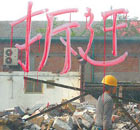Society
Official races to save heritage sites from bulldozer
By Zhao Huanxin (China Daily)
Updated: 2010-01-25 07:07
 |
Large Medium Small |
With frenzied realty development devouring historic buildings virtually every day in China, the nation faces a race against time to preserve its cultural and archaeological sites.
Shan Jixiang is the man leading that charge. As director of the State Administration of Cultural Heritage, he has probably rescued more ancient relics from bulldozers than anyone else.
"You can never place too many heritage sites under protection. The world and our descendants deserve to be able to enjoy these relics. I only wish we could protect more," he said. "As I speak, 47,000 protection workers are scouring the country for cultural treasures."
Cultural heritage protection is receiving unprecedented attention in China. Funds allocated for heritage protection have soared from 250 million yuan ($37 million) in 2002 - when Shan took over - to 4.9 billion last year, while legislation was also introduced to aid efforts.
"But despite the help we still face unprecedented challenges," said Shan.
In addition to threats from environmental pollution and the smuggling of relics, the sweeping scale of urbanization means the country has entered into a crucial period for conserving culture, he told China Daily.
Shan, an urban planner turned national political advisor, frequently travels across the country with his trusty camera trying to save China's history from being destroyed, and one of his most treasured achievements is halting a development on the site of the ancient Jinsha Ruins in western Chengdu, Sichuan province.
After a bulldozer driver accidentally uncovered a grove of golden, jade and bronze objects on Feb 8, 2001, Shan flew in from Beijing and convinced the municipal Party chief, Li Chuncheng, to give an order halting work on a realty development project on the Jinsha site. He believed archaeologists could find relics as important as those found at the Sanxingdui Ruins in 1929.
| ?
 |
With the bulldozers gone, archaeologists found more than 5,000 precious relics at Jinsha. "The Chengdu government eventually asked archaeologists to turn the ruins into a museum, which is now an attraction for tourists," said Shan. His agency granted Jinsha national heritage status in 2006. The gold-leaf sunbird - a relic believed to be about 3,000 years old excavated from Jinsha - is now the emblem of China Cultural Heritage.
But not all cities appreciate the value of heritage in promoting their image and economic development, he said.
Pointing at a picture taken in a city in central China a few years ago, he said: "My camera caught only a small part of this artificial fountain pool." The city, like many others in China, he said, had demolished historic streets to make room for monstrous edifices, golf courses and a huge fountain square.
Another photo depicted a residential quarter in Beijing where skyscrapers dwarfed several sprawling traditional buildings. Those living in these tall structures in dilapidated streets seemed to have been penalized by developers' ambitions, he said, adding that many complained of having no access to green areas or parking, and that their homes kept losing value while neighboring traditional buildings surged in price.
Even in the ancient city of Xi'an, Shaanxi province, the capital of several dynasties, the local airport greeted sightseers with a giant billboard showing clusters of high-rises made of steel and cement, said Shan. "How can a province with abundant cultural heritage greet visitors with such emotionless modern construction? It has way much more impressive structures to celebrate."
In stark contrast, an advertisement posted by Bangkok Airways at Xi'an Xianyang International Airport proudly showcased the historic Grand Palace to attract tourists to Thailand.
To his chagrin, in Tianjin municipality and Nanjing, Jiangsu province, some historic structures have been dismantled in recent months. He said this is down to the fact cultural sites are not given the dignity they deserve.
He said siheyuan - traditional Chinese courtyard houses - had disappeared in their thousands in recent decades because they had been deemed "no longer fit" for modern life and replaced with new apartment blocks.
"A siheyuan is ideal for one or two families, but if you crowd seven families into it how can you expect it to be fit for life?" said Shan, who lived as a child in a siheyuan. "Even a four-bed apartment would be rendered unfit for modern life if it were inhabited by four families."
Residents and authorities are today realizing the "outstanding cultural value" of siheyuan, which can now only be found in a few remaining pockets in central Beijing, he said. "In the past, a resident would gladly accept 300,000 yuan ($44,000) in compensation to give up a siheyuan. Today, you can't buy one even with 30 million yuan."
|
 |
| A stone carving on a door arch at the Dongyue Temple in Beijing. |
But it is not only ancient relics that should be protected, heritage from recent history should also be considered, he said. So far, only two plates have been found bearing the name of "people's commune", which was overwhelmingly popular throughout China about 50 years ago, said Shan.
Introduced in 1958 as a rural collective of farms, these communes served as multipurpose organizations for the direction of local government and management of economic and social activity in China. They began to be phased out in the 1980s. "If we could find another plate of the people's commune it would be a premium treasure," he said.
As a member of the National Committee of the Chinese People's Political Consultative Conference, the nation's top advisory body, Shan said he had submitted a host of proposals advocating the protection of heritage sites in danger, including the 143-year-old Jiangnan Shipyard in Shanghai.
One thing that perhaps will never disappear is China Cultural Heritage Day, which falls annually on the second Saturday in June. When Shan called for the creation of a day to raise public awareness of heritage conservation, he learned the State Council had already issued a notice stopping the setting up of special days of observance.
After persistent effort, including asking hordes of specialists to write to the authorities supporting his calls, Shan's dream finally came true in 2006.












